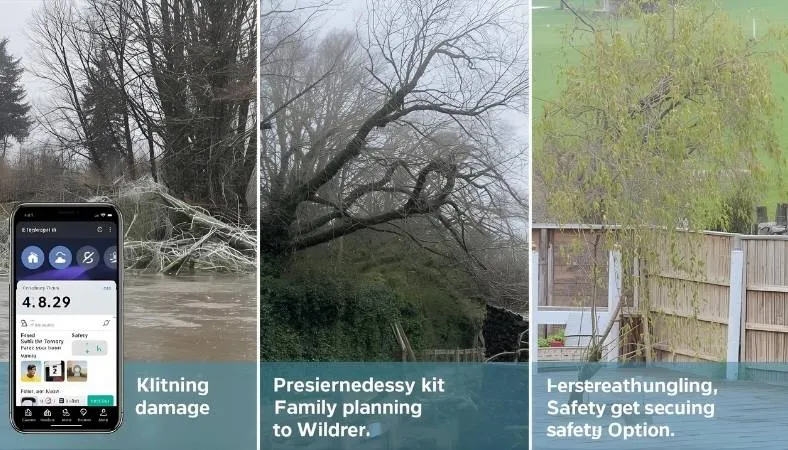Key Takeaways
Storm uk brought super strong winds, up to 96mph, knocking out power for thousands in Scotland and Ireland.
Named storms like Amy help people know when to prepare 93% of folks in warning areas heard about it!
Get ready by checking weather apps, securing your stuff, and avoiding risky travel.
Storms might not happen more often, but climate change could make rain and surges worse.
Storm uk: What Happened?
Imagine you’re at home, hearing the wind howl outside like a wolf. That was Storm Amy, the first big storm of the 2025/26 season, crashing into the UK on October 3rd and 4th. It came from the Atlantic, partly from an old hurricane called Humberto, and turned into a monster storm with crazy winds and buckets of rain. It hit hardest in places like Scotland and Northern Ireland, making trees fall and lights go out.
This storm was a big deal because it had super low pressure 947.9hPa, a record for October! Winds roared at 60-70mph in many spots, and places like Tiree in Scotland felt gusts up to 96-100mph. That’s like a car zooming down the highway! It was the strongest October storm since the UK started naming them in 2015.
Met Office Warnings Explained
When a storm’s coming, the Met Office sends out warnings to keep everyone safe. For Storm Amy, they used amber and yellow warnings. Amber means “watch out, this could mess things up big time,” like closing roads or cutting power. Yellow warnings are like a heads-up for smaller problems, like slippery roads or some rain.
Areas Hit Hardest
Northern Ireland and northwest Scotland got the worst of Amy’s temper. Amber warnings went out for these spots because winds were fierce, and there was a chance stuff could fly around, like branches or even garden trampolines. The rest of the UK, including Wales and northwest England, got yellow warnings for wind and rain. Some places saw 30-50mm of rain in just a few hours—imagine a big bucket of water dumped on your street!
Storm Amy’s Big Impacts
Picture this: you’re trying to get to school, but the bus isn’t running, and the lights at home are off. That’s what Storm Amy did to lots of people. Over 42,000 homes in Scotland and 184,000 in Ireland lost power. Trains and ferries stopped, and some roads were blocked by fallen trees. In Ireland, a man sadly lost his life in a weather-related accident, showing how dangerous storms can be.
Real-Life Stories
In Scotland, trees crashed onto train tracks—over 170 times in just a few hours! A bridge had to close because big trucks might’ve been blown over. Schools in Northern Ireland sent kids home early to keep them safe. Even London’s famous parks, like Hyde Park, shut down because the winds were too wild.
How to Get Ready for Storms
Storms like Amy can be scary, but you can be ready if you know what to do. Think of it like packing for a rainy day, but for your whole house! Here are some easy tips to stay safe:
Check the Weather: Download the Met Office app and turn on alerts for your town. It’s like getting a text from a friend warning you about trouble.
Tie Down Stuff: Got a trampoline or garden chairs? Tie them down so they don’t fly away like kites.
Charge Everything: Make sure your phone and any power banks are fully charged in case the lights go out.
Plan Your Trip: If you need to go somewhere, check if trains or buses are running. Maybe wait until the storm passes.
Help Neighbors: Check on older folks or anyone who might need a hand getting food or medicine.
Lock Up Tight: Close windows and doors, especially on the windy side of your house. If you’ve got storm shutters, use them!
During the Storm
If you’re stuck in a storm, stay inside like you’re hiding from a big monster. Don’t go near windows or try to fix things outside—that’s super risky. If you’re driving, go slow and avoid bridges or open roads where the wind can push your car. Keep away from fallen power lines; they’re dangerous!
After the Storm
Once the wind calms down, be careful. Trees and walls might be wobbly, and power lines could be on the ground. Check on your neighbors, especially if they live alone, and help them if they need to fix anything.
Named Storms: Why They Matter
Have you ever wondered why storms get names like Amy or Bram? The UK started naming storms in 2015 to make it easier for everyone to understand when bad weather’s coming. It’s like giving a storm a nickname so people pay attention. The Met Office, along with Ireland and the Netherlands, picks names from public ideas. This year, thousands of people sent in names, and Amy was one of them!
Naming storms helps a lot—93% of people in warning areas knew about Amy and got ready. That’s huge! The next storms will be called Bram, Chandra, and Dave, so keep an ear out for those.
Fun Facts About Storm Names
No names start with Q, U, X, Y, or Z to match US hurricane naming rules.
Names are chosen to be easy to say and not too controversial.
Storms get named when they might cause big problems, like strong winds or flooding.
Storms vs. Hurricanes
You might be thinking, “Isn’t a storm like a hurricane?” Not quite! Storm Amy started as part of Hurricane Humberto, but by the time it reached the UK, it was a different kind of beast. Hurricanes are tropical, with warm ocean water powering them. UK storms like Amy are more about strong winds and rain from big Atlantic weather systems. Preparing for a UK storm means focusing on things like tying down your bins, while hurricane prep might include boarding up windows.
Fun fact: If a hurricane’s leftovers reach the UK, we keep its name but call it “ex-hurricane” unless it’s bad enough to be a named storm here. Amy was special because it merged with another storm to become extra powerful.
Are Storms Getting Worse?
You might hear grown-ups talk about climate change and wonder if it’s making storms crazier. Here’s the deal: there’s no proof we’re getting more storms, but some experts think climate change could make rain heavier or storm surges—when the sea gets pushed onto land—worse. For now, storms like Amy come and go naturally, but it’s smart to stay ready.
FAQs About Storm Amy
What is Storm Amy?
It’s the first named storm of 2025/26, hitting the UK with strong winds and rain on October 3-4.
Why do we name storms?
Names make it easier to warn people about bad weather so they can get ready fast.
What’s an amber warning?
It means bad weather could cause big problems like road closures or power cuts.
How do I stay safe in a storm?
Check weather apps, secure loose stuff, charge phones, and avoid traveling if possible.
Did Storm Amy hurt anyone?
Sadly, one person in Ireland died in a weather-related accident during the storm.
Are storms getting more common?
No clear increase, but climate change might make rain and surges stronger.
Stay Safe and Weather-Aware
Storm Amy showed us how wild weather can be, but you can stay one step ahead. Download the Met Office app, keep an eye on warnings, and make sure your home is ready for the next big blow. Next time you hear about a storm like Bram or Chandra, you’ll know exactly what to do stay safe and help your neighbours!



